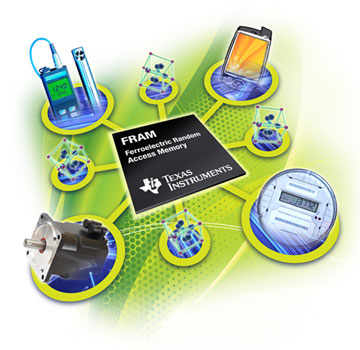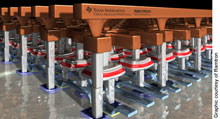Why FRAM?
The world today is becoming increasingly more networked; there is the demand for significantly more information, instantaneously - irrespective of location. What is driving this need? Amongst others, the push to make more effective, efficient and timely decisions stands out (enabling lower cost, increased safety and security). This movement is driving three macro trends in areas of our daily life - Wireless, Low Power and Security - that are shaping the need for new technologies, with capabilities that allow us to fulfill this continued thirst for information.
Wireless:
Wired communication infrastructure is becoming more expensive and difficult to install, both in heavily populated/developing countries (such as in Asia) and in remote areas. Accelerating a trend that started to gather steam 15 years ago, wireless communication increasingly offers the advantages of easier, quicker or cheaper infrastructure build and maintenance. |
 |
Low Power
As the world embraces energy conservation and green energy, and tries to recover from the impact of the latest oil price spikes in 2008 on the global economy, we look for ways to extend or gain independence from petroleum-based energy sources. Several governments around the world are introducing legislation or plans rewarding responsible energy usage. In addition, especially for remote area operation and battery powered mobile units, low power operation is a must. Devices that are able to harvest or scavenge energy from the environment (thermal, solar, vibration etc) are not only able to extend battery life (or eliminate battery needs altogether), but also reduce maintenance costs significantly. Wireless remote sensors are an example of an application that benefits greatly from very low power use and energy harvesting.
Security
As data collection, communication, and storage is increasingly used to identify and authenticate things and people, and as automated data based decision intelligence starts to pervade our daily life, data privacy concerns and consequently, security (especially during communication and storage) needs have increased tremendously.
Illustrating the convergence between the macro trends we have identified here is the global shift towards chip based contactless & batteryless passports and ID/health cards.
The impact of these macro trends on technology is essentially the demand for higher performance at lower power, coupled with, of course, business needs for faster time to market and lower total cost of ownership. This is driving the need for new technologies at both the overall solution and underlying technology levels.
What is the impact of these 3 macro trends on non-volatile memory technologies?
Looking at non-volatile memories, especially in embedded applications, the three macro trends are driving innovation in the core technologies. Non-volatile memory characteristics that would benefit the user include
- Capability of being universal memory – the ability of the same memory block to function as cache(RAM)or code or data storage memory; allowing developers to dynamically (via application software for example) partition the memory depending on real time application needs.
- Faster memory access speeds, especially for write (to be used as cache memory/RAM)
- Lower power consumption, especially during write/update
- Higher Write Endurance (number of write cycles)
- Higher inherent security
- Lower total cost of ownership
Several of these needs were not requirements or even considerations when the previous generation of embedded non-volatile memory technologies was developed in the early 1980’s. So it is not surprising that today’s non-volatile memory technologies do not exhibit some or several of these characteristics. To realize the complete vision and benefits of the macro trends, we need a ‘next generation’ technology that does have the features listed above.
FRAM is at the forefront of these ‘next generation’ memory technologies; it is the most proven and mature, having been used for the past several years in diverse applications from battery backed SRAM replacement devices to automotive applications.
And Texas Instruments is continuing our tradition of innovation – to deliver embedded FRAM products that bring real, tangible value to our customers and partners.
Back to Top
Key FRAM benefits include:
- Universal memory – offering developers the freedom to dynamically partition memory between cache(RAM), data storage and code space
- Higher write endurance (> 1014 read/write cycles)
- Lower power (read and write at 1.5 V, no charge pump needed unlike flash or EEPROM)
- Faster access speeds (up to 50ns access times)
- Higher inherent security
- Superior radiation resistance (negligible terrestrial Soft Error Rates)
These unique features will provide our customers and partners with the capability to differentiate themselves and open the door to several new applications.
Back to Top
Examples of applications that FRAM enables include:
High Write Endurance (SRAM Replacement) applications
- Digital rights management (>10 million write cycles)
- Data logging, remote sensor applications
Low Power Electronics
- Mobile & Wireless applications
- Replace battery backed SRAM (to eliminate quiescent current)
- “Energy harvesting” (especially with Low Power Wireless, RFID technologies)
- RFID applications
Cost efficient Microcontroller System-On-Chips
- Inventory efficiency (ability to dynamically partition memory)
- Reduced time to market
Emerging applications
- Instant on/off devices (Fast access speeds, low power)
- Medical applications (Radiation resistance)
Back to Top
|
